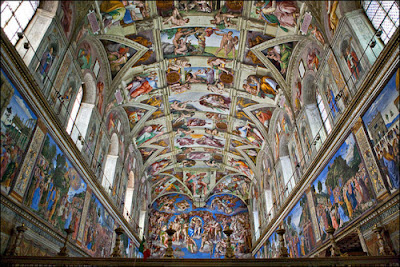 |
| Jesus covered for Lent Pantheon |
 |
| The Floor of the Pantheon in the rain |
And as was the case thirty years ago, I was astounded by the
degree to which the Catholic Church defined my experience of Rome. Of course,
my visit coincided with Francesco’s induction, so perhaps there was more
Catholic pomp and circumstance than usual. And I have to admit that, in the
moment, I was swept up by all the excitement: as I did my morning run along the
Tiber on Tuesday, listening to the sounds of the Vatican choir interspersed
with Francesco’s address to the world, I looked left up via della
Conciliazione, and there he was up the end of the street. I almost wished I was
Catholic. I also loved the familiar sight of black robed priests young and old,
rushing, walking, riding mopeds and bicycles through the streets, defining the
world around them.
 |
| The floor of Basilica di Santa Maria sopra Minerva the sun shines through a stained glass window |
And then in the basilicas and churches where I joined the
tourists, it was a different kind of tension between the Church and the
mignons. In the oldest of old, the Pantheon, a shaft of daylight penetrates
the wondrous vaulted ceiling and illuminates the world below. This
architectural wonder is heaving with tourists, and so I took a seat out of the
rain (because the hole in the ceiling opens the basilica to all elements, not
just sunlight. My sense of the crowd was that they were very well behaved. As
people do, they chatted among themselves, read their guidebooks out loud and
asked me to take their photographs (somehow I became the official Pantheon
photographer for all Italian tourists who needed to record their moment
together with Jesus at the altar). And then, as if negating the beauty and
wonder of the shaft of light, a voice over the loudspeaker announced in five
different languages, that is, five repetitions, “Please respect the silence in
this Basilica”. I wondered why it had obviously not occurred to them that the
loudest, most disrespectful noise was the booming voice telling everyone to
keep quiet. There was no opportunity for quiet contemplation as the
announcement was loud and long.
As I entered Santi Vincenzo e Anastasio, on the same piazza
as the Trevi fountain — read: church was all but empty — I was surprised not to
see the requisite young priest protecting the sacred spaces. That was, until I
sat down and rested my tired feet on the kneeler. All of a sudden he appeared,
or more likely, bolted through a hatch in a door that must have extended 20
feet up the left transept. He reprimanded me through the familiar Italian
mixture of gestures and words, turned around and raced back through the hatch.
A group of elderly women appeared and were gathered around one of the chapels
at the back, obediently listening to their guide. Lo and behold, out he came
again. The young priest stood right in the middle of the ladies and dealt them
a warning not to go inside the chapel, even though they were quietly standing
at least two feet from the altar rail, listening to their guide. He must have
been safely back behind the door for no more than two or three minutes when an
American with a camera came and sat near me. I wanted to tell him not to take
photographs as there would be consequences, but this seemed a little too like
self surveillance. There must have been either a spy hole in the hatch of the
20 foot door, or a surveillance camera. I couldn’t see a camera anywhere – so I
imagined the young priest sitting behind the door, eagerly awaiting the next
infringement of his domain.
In the Basilica di Santa Maria sopra Minerva, a major church
in the Roman Catholic order, an old priest sat next to a makeshift table selling
books on Michelangelo, reading his iphone. He showed complete disinterest in
any of the goings on in the Basilica. I watched a group of tourists from India
stroke the legs of Michelangelo’s Il
Cristo. The smooth erotic surface of the perfect form is of course, just
waiting to be stroked, so why not. A group of young Italian school children
were being led around, given a talk on each of the Basilica’s attractions.
While they were relatively well behaved, by the time they reached the Carafa
chapel with Filippino Lippi’s frescoes, they couldn’t contain themselves. One
chased another around the altar space and the others followed, and the let out
muffled shrieks. The priest did not look up from his iphone.
 |
| The floor just outside the Basilica San Pietro |












